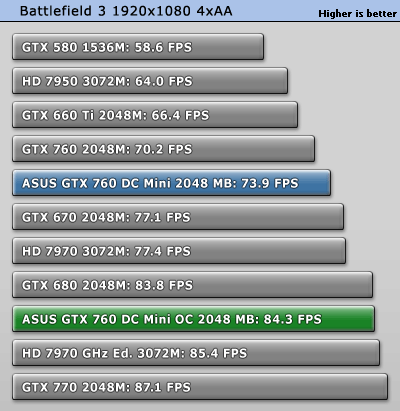 16
16
ASUS GTX 760 DirectCU Mini 2 GB Review
Temperatures & Clock Profiles »Overclocking
The overclocking results listed in this section were achieved with the default fan and voltage settings as defined in the VGA BIOS. Please note that every single sample overclocks differently which is why our results here can only serve as a guideline for what you can expect from your card.On NVIDIA cards with boost, the values discussed here are base clock. Boost will further increase clocks.

Maximum overclock on our card is 1130 MHz GPU base clock (12% overclocking) and 1810 MHz memory (21% overclock).
Overclocking the ASUS GTX 760 DC Mini yielded the lowest GPU overclock we've seen so far from a GTX 760, but the difference is quite small. Overclocking shouldn't be the primary focus for a small form factor product anyway, so the slightly lower clocks are not a big deal.
| Maximum Overclock Comparison | |||
|---|---|---|---|
| Max. GPU Clock | Max. Mem Clock | Max. OC Perf. | |
| ASUS GTX 760 DC Mini | 1130 MHz | 1810 MHz | 84.3 FPS |
| MSI GTX 760 HAWK | 1225 MHz | 1880 MHz | 90.9 FPS |
| MSI GTX 760 Gaming | 1180 MHz | 1960 MHz | 87.8 FPS |
| NVIDIA GTX 760 | 1140 MHz | 1760 MHz | 79.2 FPS |
| Gigabyte GTX 760 OC | 1190 MHz | 1850 MHz | 86.6 FPS |
| Palit GTX 760 JetStream | 1140 MHz | 1750 MHz | 82.9 FPS |
| EVGA GTX 760 SC | 1220 MHz | 1840 MHz | 88.8 FPS |
| ASUS GTX 760 DC II OC | 1175 MHz | 1840 MHz | 86.5 FPS |
differently based on random production variances. This table just serves to provide a list of typical
overclocks for similar cards, determined during TPU review.
Overclocked Performance
Using these clock frequencies, we ran a quick test of Battlefield 3 to evaluate the gains from overclocking.
Actual 3D performance gained from overclocking is 14.1%.
Jul 1st, 2025 22:48 CDT
change timezone
Latest GPU Drivers
New Forum Posts
- PCMA2305 Phase Change Metal Alloy (PCMA) (7)
- Best motherboards for XP gaming (18)
- What would you buy? (32)
- Is my m2 possibly fake ? and possible laptop hardware damage ? (28)
- HP Zbook 15 G2 GPU Upgrade (4)
- Help me overclocking my GSkill Ripjaws 3200MHz CL 16 DDR4 RAMs. (20)
- MACPRO 3,1 booting windows (0)
- My PCIe5 SSD is slow. Samsung 9100 PRO (29)
- Steering wheels, I think I had a mea culpa! (0)
- My PSU died.. (1)
Popular Reviews
- ASUS ROG Crosshair X870E Extreme Review
- Crucial T710 2 TB Review - Record-Breaking Gen 5
- Sapphire Radeon RX 9060 XT Pulse OC 16 GB Review - An Excellent Choice
- AVerMedia CamStream 4K Review
- Upcoming Hardware Launches 2025 (Updated May 2025)
- AMD Ryzen 7 9800X3D Review - The Best Gaming Processor
- Lexar NQ780 4 TB Review
- Sapphire Radeon RX 9070 XT Nitro+ Review - Beating NVIDIA
- AMD Ryzen 9 9950X3D Review - Great for Gaming and Productivity
- NVIDIA GeForce RTX 5060 8 GB Review
TPU on YouTube
Controversial News Posts
- Intel's Core Ultra 7 265K and 265KF CPUs Dip Below $250 (288)
- NVIDIA Grabs Market Share, AMD Loses Ground, and Intel Disappears in Latest dGPU Update (208)
- Some Intel Nova Lake CPUs Rumored to Challenge AMD's 3D V-Cache in Desktop Gaming (140)
- NVIDIA GeForce RTX 5080 SUPER Could Feature 24 GB Memory, Increased Power Limits (112)
- Microsoft Partners with AMD for Next-gen Xbox Hardware (105)
- NVIDIA Launches GeForce RTX 5050 for Desktops and Laptops, Starts at $249 (105)
- Intel "Nova Lake‑S" Series: Seven SKUs, Up to 52 Cores and 150 W TDP (100)
- NVIDIA DLSS Transformer Cuts VRAM Usage by 20% (91)